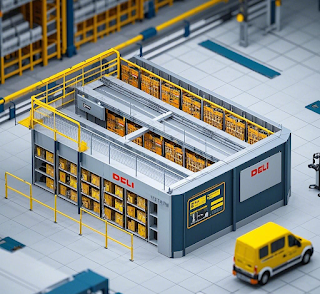Key Considerations in Automated Warehouse Design for Internal Logistics
In the early stages of automated warehouse design, it is critical to holistically evaluate multiple aspects of requirements and constraints to ensure the proposed solution aligns with the client's practical needs and maintains feasibility.
1. Customer Profile
Customer Information: Company name, address, contact person, phone number, project location.
Project Start Time: Define the timeline for design, procurement, and construction.
2. Project Basic Information
Site Conditions:
New plant or existing plant renovation?
Warehouse dimensions (length, width, height).
Site limitations (e.g., ground cracks, uneven surfaces, ceiling obstacles).
Storage Environment:
Ambient temperature range.
Special requirements (temperature/humidity control, dust-free, fire safety).
3. Goods Specifications
Type: Raw materials, semi-finished/finished products, parts, etc.
Special Properties: Refrigeration, hazardous materials, irregular shapes, high-temperature goods.
Packaging: Boxes, bags, bins, cages, etc.
Stacking Method: How goods are arranged on pallets.
SKU Types: Total number of material categories.
Unit Size & Weight: Dimensions and weight of the smallest storage/picking unit.
4. Carrier Details
Type: Pallets (e.g., “Chuan”-style, “Tian”-style), bins, cages.
Dimensions: Length, width, height (new or existing carriers).
Material: Plastic, wood, metal, stainless steel.
Load Capacity: Maximum weight per carrier (including the carrier itself).
5. Storage Capacity Requirements
Maximum/Minimum Stock: Expected pallet/bin/unit quantities.
Empty Carrier Storage: Whether empty pallets/bins need storage (stacked or single units).
6. Inbound Specifications
Efficiency: Peak/average inbound operations per hour/day.
Operation Hours: Daily inbound schedule or total working hours.
Current Process: Manual, forklifts, cranes, etc.
Inbound Direction: Same as outbound, opposite, multi-layer, etc.
7. Outbound Specifications
Efficiency: Peak/average outbound operations per hour/day.
Operation Hours: Daily outbound schedule or total working hours.
Current Process: Manual picking, automated systems, etc.
Outbound Mode: Full-pallet retrieval, piece-picking, conveyor systems, robotic arms.
Pallet Usage: Internal circulation, dispatched with goods, factory-wide use.
Outbound Direction: Same as inbound, opposite, multi-layer, etc.
8. Information Management
Cargo Tracking: Barcodes, RFID, QR codes, or manual logging.
Control Room: Central control room location (on-site or separate).
System Integration: ERP/MES compatibility.
9. Additional Requirements
Special Needs: Any unique requests not covered above.
10. Project Progress
Phase: Early planning, finalized design, tendering, etc.
11. Remarks
Communication: Further discussions with the client are critical for detailed design.
Scope: This survey applies to standard AS/RS, not shuttle-free or e-commerce sorting systems.
Summary:
In the early stages of AS/RS design, gather comprehensive data on customer needs, site conditions, goods specifications, carrier types, storage capacity, inbound/outbound workflows, and IT systems. Clear communication ensures the design aligns with practical requirements and lays a foundation for successful implementation.
Suzhou Deli Group, leveraging years of industry expertise and a dedicated team of specialists, meticulously addresses each project by thoroughly understanding client needs and delivering tailored solutions. The company consistently achieves a 100% annual project delivery rate.




Comments
Post a Comment